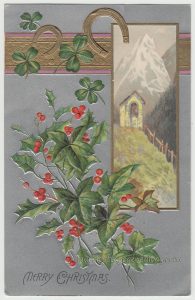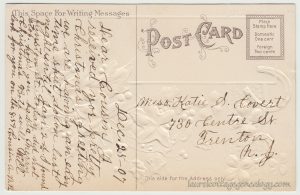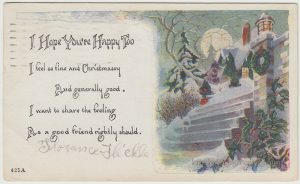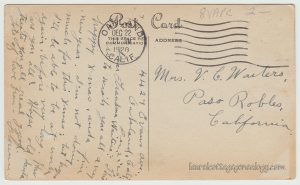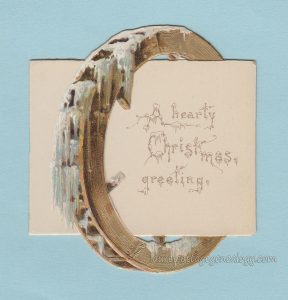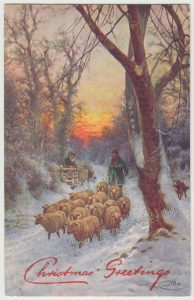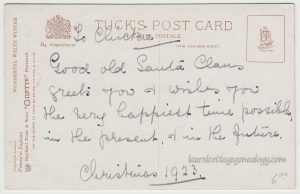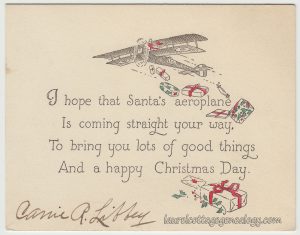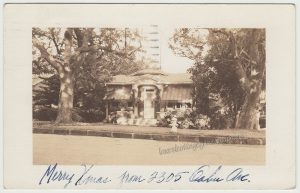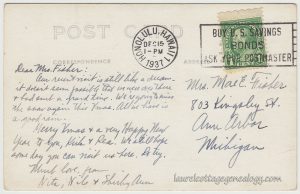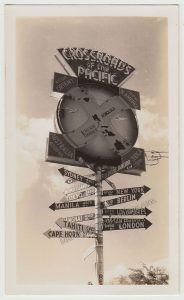
Photo, white border. Circa 1938 – December 1948.
Availability Status: SOLD Size: 2 and 3/4 x 4 and 9/16″
H. P. “Sunny” Sundstrom’s famous neon sign adjacent to his restaurant Kau Kau Korner, located at the corner of Kalakaua Avenue and Kapiolani Boulevard, Honolulu, Hawaii. Arrow markers point the way and give the distance to some of the major cities around the world. The sign was up from about 1938 to 1960. Photographed here prior to the addition of the “Kau Kau Korner” portion that was later added on top.
From a Google search, images of Kau Kau Korner Crossroads of the Pacific sign:
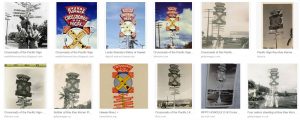
I don’t know about you, but whenever I see an arrow sign (virtual or in real life) pointing to a far away place, I picture myself earnestly embarking on the journey, deviating off course only to skirt obstacles, until finally arriving at the stated destination. Maybe it’s a carryover from the signposts I saw on family trips as a child, or some subconscious bird flight path thing. Anyway, while scrutinizing different photos of the sign I noticed that the same city in one shot sometimes is at a different angle than another (compared to its counterparts). I had that instant flash of “Hey, wait…..” like, if we’re using the bird example, a feeling that my flight path’s messed up. 😉 Of course, the markers were not meant to be necessarily precise. In addition, signposts in general just beckon to be climbed and hung on, (such a great photo op!) so even if they were correct when placed, the arrows would naturally tend to get moved around a little, or maybe you get some wiseacre deciding to change the arrows all around for fun. But this was a sidetrack, I was scrutinizing various images in order to try to pinpoint when the “Kau Kau Korner” part got added to the top of the sign, in order to try to date the photo. Then got to thinking, for such a well-known landmark (at one point the public bought more Kodak prints of the Crossroads of the Pacific sign, than those of the King Kamehameha statue, the signpost having also appeared in newsreels and in the magazines Time, Life, Look and Fortune) and (getting sentimental here) for one that oversaw a lot of life in its 20-plus years, including during WWII, wouldn’t there be a timeline somewhere? We didn’t find one, so decided to include a partial one below.
Back to the photo
Our image above, circa 1940s, and must have been a commercial-type photograph rather than someone’s snapshot. There’s currently one for sale on eBay under the title “Vtg 1940’s B&W Photo – Crossroads Of The Pacific Sign Honolulu Hawaii #827” that has the exact same angle, placement of the arrow markers and the clincher: cloud formation. The eBay one is black and white while ours has a sepia tone. Not sure if the eBay seller had cropped their image or not.
The Hamburger King of Hawaii
A self-made man, Hanley Paul “Sunny” Sundstrom (1909 – 1965) was a Minneapolis native who grew up in Kingsburg, Fresno County, California before coming to Hawaii about 1932. He sold magazines door-to-door before he and a partner opened a burger shack in 1935 for the cost of $900.00, for want of a “decent hamburger.” At that time a burger in that neck of the woods was a just a grilled patty “thrown together” with a bun, minus the usual accompaniments we expect today. About five months (reports vary) after the 3-person operation started, with Sunny as dishwasher, his partner as cook, and the partner’s girlfriend as waitress, Sunny bought out the partner. His restaurant Kau Kau Korner, along with the Crossroads of the Pacific sign, went on to make him famous, as evidenced in postcards he received from all over the world, including one addressed to “Hamburger King of Hawaii” and another to “Sunny Sundstrom, Pacific Ocean.”
An icon is born
It was about 1938 that a friend of Sundstrom’s approached him with the idea that would make him famous. From journalist, Jane Evinger’s article “Kau Kau Burger King Abdicates To Take Over Pancake Palace” that appeared in The Honolulu Advertiser, February 21, 1960:
“A friend of mine told me that he had a fantastic idea that would make me famous from the North Pole to the South Pole, but that it would cost me $100….I’ve always been a good gambler, so I gave him the $100, and all he said was ‘Crossroads of the Pacific.’ I figured $100 was pretty expensive for that, since the Islands have always been known as Crossroads of the Pacific, but I kept thinking about it and sure enough it has paid off.”
Onward and outward….1941 expansion ad and photos
Sunstrom expanded Kau Kau Korner in 1941, at the cost of about $45,000. Below, an ad and photo appearing in The Honolulu Advertiser, August 14, 1941. Note the many missing letters for “Broiled Steak” and “Fried Chicken” on the restaurant exterior, and you can see a ladder on the right, so the photo must have been taken when they were still putting on the finishing touches.
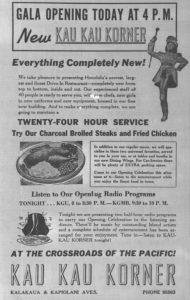
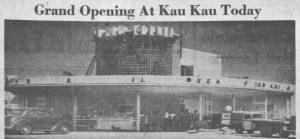
Below, beautiful waitresses in new uniforms, from The Honolulu Star-Bulletin, August 13, 1941.
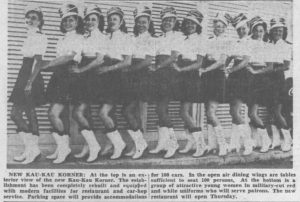
Sydney was Sydney, then Sidney, then Sydney
Back to the question….when was the top part of the sign “Kau Kau Korner” added? Sometime between about December 1941 and December 1948. The exact date was not found, but articles on a misspelling provide the estimate:
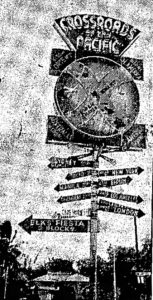
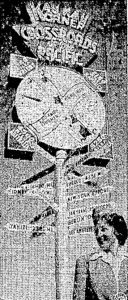
Above left, a photo that appeared with a short news clipping December 4, 1941 in The Algona Upper Des Moines. If you enlarge the image you’ll see that the sign for Sydney (Australia) situated on the top left among the markers, has the correct spelling for that city. The sign in this photo, is minus the “Kau Kau Korner” portion that had been added to the top of the sign later on. Note the larger marker at the bottom that says “Elks Fiesta” and the number of blocks to get there, indicating the signpost was sometimes used for local events.
Above, on our right, a photo that appeared December 24, 1948 in the Lubbock Evening Journal. This image shows the misspelled “Sidney” signpost, as well as the addition of “Kau Kau Korner” portion on top. That’s airline stewardess Marge Tolosano posing in the shot.
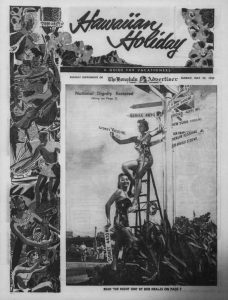
Above, from the front page of the “Hawaiian Holiday” section of The Honolulu Advertiser, May 22, 1955: Models in swimsuits, Sally Lee and Charlene Holt (atop ladder) replace the “Sidney” arrow with one showing Sydney. The correction was made at the request of Mrs. Yvonne Coopersmith, of Australia. And, though the story ran in May, evidence posted on the website Tiki Central indicates the marker was corrected in March.
Kau Kau Kitchen
Kau Kau Korner closed February 21, 1960, due to loss of lease. That following July, Sunny Sundstrom opened Kau Kau Kitchen. At that time the Honolulu Star-Bulletin ran a nice big article (rightly so, of course) for the new pancake house, but we particularly like this short clip from 1961, also from the Star-Bulletin. It’s rather touching, and gives a partial description of the interior. We’d love to see any old photos that someone might have of the mural.
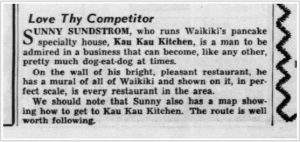
A partial timeline
1935 Hanley P. “Sunny” Sundstrom and partner open a burger shack, a counter restaurant with six stools; Sunny buys out partner after about five months.
About 1938 Crossroads of the Pacific Sign goes up for the cost of $100.00 at the idea and offer from a friend.
August 1941 Kau Kau Korner restaurant re-opens after a $45,000.00 upgrade and expansion. To the menu is added sirloin steak and fried chicken. Menus from that time show the restaurant was open 24/7 and that the menu was a pretty extensive one.
December 1941 photo showing that the arrow for Sydney (Australia) was spelled correctly. Sign is without the “Kau Kau Korner” addition on top.
December 1948 photo showing the “Kau Kau Korner” portion on the top and the sign for Sydney is now incorrectly showing “Sidney.”
March 1955 the marker for Sydney, Australia is corrected. The Honolulu Advertiser, runs the photo on the cover page of its “Hawaiian Holiday ” section, dated May 22, 1955.
February 21, 1960, Sunday evening, Kau Kau Korner restaurant and drive-in serves its last meal. The property owner decided not to renew the lease. Per Sundstrom, much of the equipment was planned to be auctioned off. Crossroads of the Pacific sign “probably” to go up outside his upcoming pancake and Kentucky Fried Chicken restaurant, Kau Kau Kitchen.
Kau Kau Korner restaurant is being converted to Coco’s Coffee House by the new renters, the firm Spencecliff (Spence and Cliff Weaver.)
July 1960 Sunny Sundstrom opens Kau Kau Kitchen at 2154 Kalakaua Avenue, Waikiki, the site of the former Melting Pot restaurant. Specializing in Sundstrom’s twenty best pancakes recipes from his stash of over 100 recipes and also offering Kentucky Fried Chicken. The Crossroads of the Pacific sign is not found mentioned in any newspaper articles for Kau Kau Kitchen or in any for Coco’s Coffee Shop.
October 1960 Coco’s Coffee House opens at site of the former Kau Kau Korner Restaurant.
November 11, 1965 Hanley P. “Sunny” Sundstrom dies in Tijuana, Mexico, while undergoing treatment for cancer, leaving a wife and two daughters, and a sister.
August 1986 Coco’s Coffee House is torn down.
July 1987 the Hard Rock Cafe opens at the site of the former Coco’s location. In 2010 the business moves to Waikiki Beach Walk.
Currently, a replica of the Crossroads of the Pacific sign, with arrow markers primarily showing distances to military bases, is up outside the Pearl Harbor Visitors Center.
____________________________________________________________________________
Sources: “images of Kau Kau Korner Crossroads of the Pacific sign.” Google.com search. Accessed December 15, 2018.
Evinger, Jane. “Kau Kau Burger King Abdicates To Take Over Pancake Palace.” The Honolulu Advertiser. February 21, 1960. Sunday, p. F-4. (Newspapers.com).
“New Kau Kau Corner Opens Thursday.” Honolulu Star-Bulletin. August 13, 1941. Wednesday, p. 10. (Newspapers.com).
“Crossroads of the Pacific.” The Algona Upper Des Moines (Algona, IA). December 4, 1941. Thursday, p. 7. (Newspapers.com).
“Wither Away?” Lubbock Evening Journal (Lubbock, TX). December 24, 1948. Friday, p. 5. (Newspapers.com).
“National Dignity Restored.” The Honolulu Advertiser. May 22, 1955. Sunday, cover page. (Newspapers.com).
Tiki Central (www.tikiroom.com). Accessed December 22, 2018.
Sigall, Bob. “Crosswords, sign marked popular Honolulu drive-in.” Honolulu-Star Advertiser. April 27, 1912. Friday, p. B2. (Newspapers.com).
“Pancakes Reign in Kau Kau Kitchen.” The Honolulu Advertiser. October 3, 1960. Monday, p. 13. (Newspapers.com).
“Love Thy Competitor.” Honolulu Star-Bulletin. May 28, 1961. Sunday, p. 76. (Newspapers.com).
“H. Sundstrom Dies; ‘Kau Kau’ Owner.” The Honolulu Advertiser.” November 13, 1965. Saturday, p. 20. (Newspapers.com).

